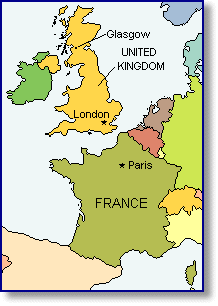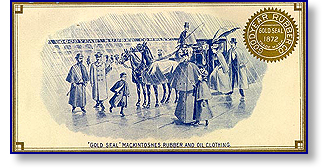Balloons and Raincoats
< Back | Main menu | PSLC | Next >
Up, Up and Away...
 We're in France now, and the year is 1783. We're here to watch the brothers Joseph-Michel and
Jacques-�tienne Montgolfier hatch
their latest plan. These fellows have finally come up with something that Europeans can do
with rubber. This is their hot air balloon, the first one ever made. These things
aren't very useful just yet, but in a time when only birds, bats and bugs knew how to fly, a
balloon was a spectacle. People flock to see them.
We're in France now, and the year is 1783. We're here to watch the brothers Joseph-Michel and
Jacques-�tienne Montgolfier hatch
their latest plan. These fellows have finally come up with something that Europeans can do
with rubber. This is their hot air balloon, the first one ever made. These things
aren't very useful just yet, but in a time when only birds, bats and bugs knew how to fly, a
balloon was a spectacle. People flock to see them.
What is important to us is what the balloon is made out of. It is made from rubberized canvas. Making rubberized balloon fabric is not that difficult. One first dissolves natural rubber in turpentine, then applies the solution to a sheet of canvas. When the turpentine evaporates, one is left with rubber coated fabric, which works well for containing hot air, the kind used to make balloons float.
This is nothing new. People in the Americas had been making rubberized cloth since pre-Columbian times. But it is the first big use for rubber in the Old World. Rubber still has problems when it's cold, but one can presume that since balloons are filled with hot air, that this isn't a problem for the Montgolfiers. But other uses for rubberized fabric are soon to follow, and wintertime will still spell trouble for rubber.
Let's go now across the English Channel to Britain, and ahead in time to 1819 to see what a fellow named Charles Macintosh is up to.
One Dry Scotsman
Charles Macintosh is running a dyeing business in Glasgow at this point. He uses ammonia produced from coal tar to make his dyes, and hasn't really had any use for the leftover coal tar sludge. Naphtha could be obtained from the sludge, so he has been trying to come up with a use for that. After playing with it he has found that naphtha is a really good solvent for natural rubber. This has started turning the wheels in Macintosh's brain. Since naphtha is so much better at dissolving natural rubber than turpentine, maybe he has a better way to make rubberized cloth. So he spreads out a piece of fabric, then a layer of his rubber solution like jelly on bread, and then finishes his sandwich with a second piece of fabric on top.

|
|
Hancock is also interested in rubberized fabric, and he figures out how to make multi-piece items from rubber by sticking the pieces together while they are hot, and thus melding them together. This works better than to try to stitch them. This solves the problem of the leaky stitch holes. Hancock and Macintosh will go into business together making raincoats, and in Britain raincoats will be called "macks" from now on.
Yuk!
But the new macks don't work in the United States. One has to remember that Britain has a very different climate from the United States. In Britain it certainly never gets very hot, but it never gets terribly cold either, unlike the rest of northern Europe. So in Britain natural rubber's problems at temperature extremes aren't that important. But in the U.S., Macintosh's raincoats don't work well in the north because northern winters are too harsh, and they don't work in the south because summers there are so hot that the rubber gets gooey. Rubber's problems will linger until an unemployed hardware store owner from New Haven, Connecticut named Charles Goodyear has a small accident.But the British rubber market was booming, and soon Hancock and Macintosh are using more rubber than they can import from Brazil. But don't worry Hancock has a solution to his supply problem...
-
Next stop: London - Hancock's Pickle
Meanwhile...
While Macintosh is making raincoats, this is going on in the rest of the world:
-
1821: In the United States, Sequoyah finishes work on a sophisticated system for writing the
Cherokee language.
1821: In west Africa, free African-Americans establish the nation of Liberia. (Liberia will eventually become an exporter of natural rubber.)
1827: In New York City, daycare as we know it is born when Joanna Bethune and Hannah L. Murray open the first modern nursery school, caring for the children of low-income working mothers.
For more information, at other websites...
-
Why Are Balloons
Stretchy? - information on the rubber in balloons, as well as activities using balloons to
demonstrate gas behavior, from Newton's Apple, a production of KTCA Twin Cities Public
Television.
The History Of Ballooning: The Feat of the Montgolfier Brothers - the story of the first balloon, by G�rard Chauvy for the Arizona Balloon Club.
Charles Macintosh - a biographical sketch, part of "Science on the Streets" from the University of Strathclyde.
Bibliography
1. Burke, James. Connections. Boston: Little, Brown and Co., 1978.
-
An ad for rubberized raincoats from the 1800s: Courtesy Goodyear Rubber and Supply.
Polymer Science Learning Center and the Chemical Heritage Foundation
